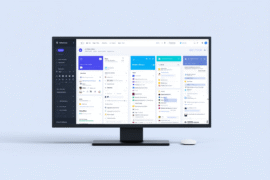This article may contain references to products or services from one or more of our advertisers or partners. We may receive compensation when you click on links to those products or services. Nonetheless, our opinions are our own.
The information presented in this article is accurate to the best of our knowledge at the time of publication. However, information is subject to change, and no guarantees are made about the continued accuracy or completeness of this content after its publication date.
According to Business Research Insights, the global ad server market was $2310 million in 2021. It is projected to reach $4896.8 million by 2032 at a CAGR of 7.07% during the forecast period. WebEx notes that enterprises have a more than $1.2 billion yearly PPC budget through Google. Statistics show that online advertising is crucial for brand communication in today’s business environment.
Recent data shows that almost 1 billion people worldwide use ad blockers. To address the challenge of satisfying user needs and ad content, publishers must discover fresh methods for designing, positioning, and executing their advertisements. This is where the ad server comes for help.
What Is an Ad Server?
An ad server is a web-based marketing server or software that places advertisements on third-party websites. Like other components of RTB, it offers advertising display on the owner’s website, counts total demonstrations and clicks, and has a range of tools for boosting ad campaigns.
The ad server is a database. It performs many functions. Among the main ones are storing ads and transferring them to the website, considering the marketing network’s key requests. It is characterized by regular updates, thanks to which it is possible to display new banners or text ads during each new page load.
Ad Server vs. DSP
An ad server handles the delivery of ads. It stores the ad content, determines which ad to show based on user data and preferences, and tracks performance metrics like views and clicks. It’s the system that ensures your ad gets to the right place at the right time.
A DSP is a tool for buying ad space. It allows advertisers to purchase inventory across various ad exchanges in real-time. Through ad serving, advertisers can set targeting criteria and bid on ad spaces to optimize their campaigns and ad spend.
History of Ad Servers
The first independent server of advertising type was introduced to the world in 1995, thanks to a well-known company called FocaLink Media Services. Interestingly, its motherboard is still carefully monitored to this day.
In 1996, another equally important event happened – the company restarted its ad server through a subsidiary company called SmartBanner, with an office in Palo Alto (United States). D. Zinman, E. Knru, and D. Strober created it. Two years later, the name was changed to AdKnowledge, while the company continued to exist under the new holding company ModusLink Global Solutions. Currently, the brand operates under the trademark of an American company from Kansas City, which successfully bought it out in 2004.
In 1996, the world saw the first Ad Server. It was released by NetGravity, headed by T. Shields and J. Denver (San Mateo, California), for marketing cooperation. Two years after these events, the firm went public, and in 1999, full control was secured by DoubleClick. The event that followed was a name change to DART. In March 2008, this company was bought by the world-famous corporation Google. It began to invest in it, develop the product, improve it, and launch new versions. The latest was Double Click Enterprise 8.0.
Now, there are a huge number of advertising servers for every taste, color, and advertising format. One thing is clear: imagining the advertising market without advertising servers is impossible.
Voted "Best Overall Budgeting App" by Forbes and WSJ
Monarch Money helps you budget, track spending, set goals, and plan your financial future—all in one app.
Get 50% OFF your first year with code MONARCHVIP
How an Ad Server Works
Here’s a breakdown of how an ad server operates:
- Advertisers upload their ads to the ad server, which keeps them ready for display.
- When a user visits a site or app, the ad server gets a request for an ad.
- The ad server picks the most suitable ad based on the user’s data and the available inventory.
- The chosen ad is then delivered to the user’s device.
- The ad server monitors interactions, such as impressions and clicks, providing insights into how the ad performs.
As you can see, nothing complicated.
First- and Third-Party Ad Servers
First-party ad servers are operated by the website or app displaying the ads. They manage ad delivery directly on their own platforms and provide detailed performance insights for their sites. They offer a direct view of how ads perform within their own environments.
Third-party ad servers are not tied to any particular site. They manage ads across various sites and apps, often used by advertisers and agencies to handle multiple campaigns. They offer a broader view of ad performance and are useful for tracking and analyzing ads across different platforms.
Conclusion
Ad servers play crucial but distinct roles in digital advertising. Ad servers focus on the distribution and management of ads, ensuring they reach the right audience and providing performance metrics. With the right use of ad servers, businesses can improve their advertising outcomes and stay ahead in the competitive digital landscape.

Reviewed and edited by Albert Fang.
See a typo or want to suggest an edit/revision to the content? Use the contact us form to provide feedback.
At FangWallet, we value editorial integrity and open collaboration in curating quality content for readers to enjoy. Much appreciated for the assist.
Did you like our article and find it insightful? We encourage sharing the article link with family and friends to benefit as well - better yet, sharing on social media. Thank you for the support! 🍉
Article Title: Ad Server Effectiveness: Boosting Customer Engagement and Sales
https://fangwallet.com/2025/02/24/ad-server-effectiveness-boosting-customer-engagement-and-sales/The FangWallet Promise
FangWallet is an editorially independent resource - founded on breaking down challenging financial concepts for anyone to understand since 2014. While we adhere to editorial integrity, note that this post may contain references to products from our partners.
The FangWallet promise is always to have your best interest in mind and be transparent and honest about the financial picture.
Become an Insider

Subscribe to get a free daily budget planner printable to help get your money on track!
Make passive money the right way. No spam.
Editorial Disclaimer: The editorial content on this page is not provided by any of the companies mentioned. The opinions expressed here are the author's alone.
The content of this website is for informational purposes only and does not represent investment advice, or an offer or solicitation to buy or sell any security, investment, or product. Investors are encouraged to do their own due diligence, and, if necessary, consult professional advising before making any investment decisions. Investing involves a high degree of risk, and financial losses may occur including the potential loss of principal.
Source Citation References:
+ Inspo











































